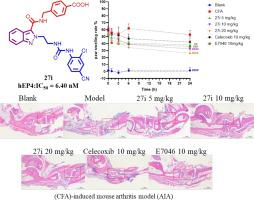前列腺素EP4受体拮抗剂治疗炎性疼痛的设计与合成
IF 4.7
2区 医学
Q1 BIOCHEMISTRY & MOLECULAR BIOLOGY
引用次数: 0
摘要
前列腺素E2 (PGE2)是主要的促炎类前列腺素,与许多疾病如疼痛、发烧、关节炎和癌症的发病机制有关。越来越多的证据表明,特异性阻断PGE2/EP4信号传导以诱导强大的抗炎和镇痛作用是一种有吸引力的治疗策略。采用支架跳跃策略,设计合成了一系列新型苯并吡唑支架的含脲衍生物。最有希望的化合物27i对EP4的抑制活性最好(27i hEP4 IC50 = 6.40 nM)。在Freund's complete佐剂(CFA)诱导的小鼠关节炎(AIA)模型中,化合物27i显著降低AIA小鼠爪子和关节肿胀、炎症细胞浸润、软骨损伤、关节膜形成和骨侵蚀,并呈剂量依赖性。在耳肿胀模型中,化合物27i的抗炎作用优于塞来昔布和E7046。此外,在亚急性安全性评价中,27i具有良好的体内耐受性。总之,本研究为治疗炎症和疼痛提供了有价值的先导化合物,值得进一步开发本文章由计算机程序翻译,如有差异,请以英文原文为准。

Design and synthesis of Prostanoid EP4 receptor antagonists for treatment of inflammatory pain
Prostaglandin E2 (PGE2) is the principal proinflammatory prostanoid and is implicated in the pathogenesis of a number of diseases such as pain, fever, arthritis and cancer. Accumulating evidence has indicated that specifically blocking PGE2/EP4 signaling to induce robust anti-inflammation and analgesic effect represents an attractive therapy strategy. A series of urea-containing derivatives of novel benzopyrazole scaffold were designed and synthesized through a scaffold hopping strategy. The most promising compound 27i exhibited the best inhibitory activity against EP4 (27i hEP4 IC50 = 6.40 nM). In a mouse model of arthritis (AIA) induced by Freund's complete adjuvant (CFA), compound 27i significantly reduced the swelling of paws and joints, inflammatory cell infiltration, cartilage damage, pannus formation and bone erosion in the joints of AIA mice in a dose-dependent manner. In the ear swelling model, the anti-inflammatory effect of compound 27i was superior to celecoxib and E7046. Besides, 27i possessed good in vivo tolerability in subacute safety evaluation. Collectively, this study provided valuable lead compounds for the treatment of inflammation and pain, which were worthy of further development
求助全文
通过发布文献求助,成功后即可免费获取论文全文。
去求助
来源期刊

Bioorganic Chemistry
生物-生化与分子生物学
CiteScore
9.70
自引率
3.90%
发文量
679
审稿时长
31 days
期刊介绍:
Bioorganic Chemistry publishes research that addresses biological questions at the molecular level, using organic chemistry and principles of physical organic chemistry. The scope of the journal covers a range of topics at the organic chemistry-biology interface, including: enzyme catalysis, biotransformation and enzyme inhibition; nucleic acids chemistry; medicinal chemistry; natural product chemistry, natural product synthesis and natural product biosynthesis; antimicrobial agents; lipid and peptide chemistry; biophysical chemistry; biological probes; bio-orthogonal chemistry and biomimetic chemistry.
For manuscripts dealing with synthetic bioactive compounds, the Journal requires that the molecular target of the compounds described must be known, and must be demonstrated experimentally in the manuscript. For studies involving natural products, if the molecular target is unknown, some data beyond simple cell-based toxicity studies to provide insight into the mechanism of action is required. Studies supported by molecular docking are welcome, but must be supported by experimental data. The Journal does not consider manuscripts that are purely theoretical or computational in nature.
The Journal publishes regular articles, short communications and reviews. Reviews are normally invited by Editors or Editorial Board members. Authors of unsolicited reviews should first contact an Editor or Editorial Board member to determine whether the proposed article is within the scope of the Journal.
 求助内容:
求助内容: 应助结果提醒方式:
应助结果提醒方式:


